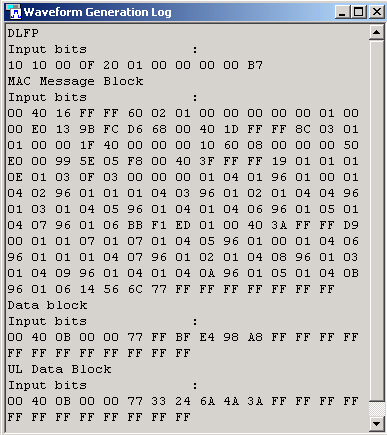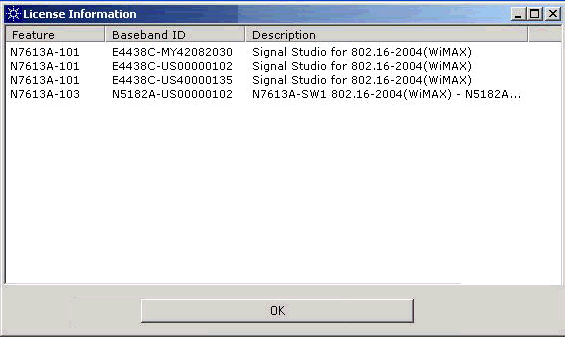
Many of the functions for the Signal Studio software are accessed from the menu bar and tool bar. The tool bar consists of a subset of the most commonly used functions found in the menu bar and can be hidden from view if desired.
Menu Bar

Tool Bar

New
 resets all parameters to default settings.
resets all parameters to default settings.
Open
 reloads a saved Signal Studio software configuration file (with an .xml
extension).
reloads a saved Signal Studio software configuration file (with an .xml
extension).
Save
 and Save As save configuration
files, allowing you to recall a specific Signal Studio software configuration.
and Save As save configuration
files, allowing you to recall a specific Signal Studio software configuration.
Export Waveform Data saves an encrypted waveform file (with a .wfm extension) to your PC. This waveform file can then be downloaded and played in other licensed signal generators. If a waveform is configured, but has not been generated, this selection also generates the waveform.
Exit closes the Signal Studio software.
Toolbar displays or hides the tool bar.
CCDF Graph  opens or closes the graph view.
opens or closes the graph view.
Frame Plot
 toggles the visibility of the time-domain bursts on the frame
plot view.
toggles the visibility of the time-domain bursts on the frame
plot view.
Waveform Generation Log opens a window to view the bits (in hexadecimal) that the software automatically generates when you are using the MAC PDU mode. The generated data for the DLFP, broadcast messages, and bursts parameters is based on your frame configuration. When you use the Physical mode, the software does not automatically generate the DLPF (contained in the FCH) and MAC Message Block; however, the window displays the burst data and any user-defined data for these components. For additional information on interpreting the data bits, refer to the IEEE 802.16-2004 standard.
To view the generated data, open the window before generating a new waveform file. The window displays the following blocks of data:

DLFP (downlink frame prefix) specifies the burst profile and length of one to four downlink bursts (if present) that immediately follow the FCH.
MAC Message Block shows the MAC messages for the DL-MAP, UL-MAP, DCD, and UCD (in that order). The burst is comprised of four concatenated MAC PDUs with CRC. Additional bytes of padding (0xFF) may be appended to fill the burst allocation.
Data Block displays the data from user created bursts in the downlink portion of the signal (if any). The MAC PDUs defined in the each burst are concatenated and shown for each user-defined burst. Additional bytes of padding (0xFF) may be appended to fill the burst allocation.
UL Data Block displays the data from user created bursts in the uplink portion of the signal (if any). The MAC PDUs defined in each burst are concatenated and shown for each user-defined burst. Additional bytes of padding (0xFF) may be appended to fill the burst allocation.
Check Parameters  verifies that the configured bursts do not exceed the length of the defined
frame. If the configuration is valid, a message "Parameters are fine"
is shown on the status bar.
If not, the message "Defined frame exceeds maximum frame time"
appears. This check is done automatically whenever the waveform is generated.
verifies that the configured bursts do not exceed the length of the defined
frame. If the configuration is valid, a message "Parameters are fine"
is shown on the status bar.
If not, the message "Defined frame exceeds maximum frame time"
appears. This check is done automatically whenever the waveform is generated.

Generate
 generates an I/Q waveform file and plots the CCDF graph in accordance
with the current channel configuration and signal generation setup. Waveform
generation time varies proportionally to the complexity of the waveform.
generates an I/Q waveform file and plots the CCDF graph in accordance
with the current channel configuration and signal generation setup. Waveform
generation time varies proportionally to the complexity of the waveform.
Download  generates (if the file is not already generated)
and downloads the current waveform file to the signal generator. The signal
generator automatically begins to play the signal.
generates (if the file is not already generated)
and downloads the current waveform file to the signal generator. The signal
generator automatically begins to play the signal.
|
|
To download a waveform file, you must have either a permanent license or a non-expired 14-day trial license for each signal generator being used. |
|
|
In some configurations, the generated waveform size exceeds 8 Msamples. In this case, it isn't possible to transfer the waveform into the ESG or PSG with Options 001 or 601. Use an ESG or PSG with Options 002 or 602 for more waveform memory. |
Local control of the signal generator can be re-enabled by pressing the Local hardkey, allowing signal generator settings to be modified from the front panel. The waveform file, however, cannot be modified after downloading it to the signal generator.
Help displays the contents of the Help system

|
|
Some Baseband Studio and Signal Studio software applications that use older licensing methods will not be listed. |
Related Topics